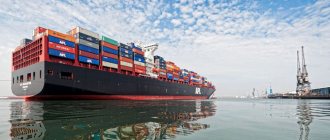home
International shipping
International transportation is used to deliver cargo and goods from various countries of the world to the Russian Federation, the so-called “import” to the Russian Federation, or vice versa from Russia abroad, the so-called “export” from the Russian Federation. The choice of mode of transport for international transportation depends on the characteristics of the cargo: its dimensions, weight, compliance with temperature conditions, location of loading or unloading, shelf life of goods and any other features that affect the speed of delivery and the transport used. The following modes of transport are used for transportation: road, air, rail, sea or multimodal “combined”, i.e. composed of several species. These types of transport can deliver any, even the most complex, cargo and goods, with the most complex requirements for their transportation. Such as: oversized, perishable, dangerous, live animals and any others. Delivery by road is widely in demand; it allows you to deliver cargo from door to door. Existing modifications of modern cars make it possible to transport cargo of various types, with different requirements for transportation conditions. By rail, goods are usually delivered over very long distances. Delivery by air is quite expensive, but very fast. International cargo transportation by water is cheaper, but is the slowest of all. At the same time, the feasibility of using a particular type of transport depends on various features and specific customer requirements.
Our company carries out international transportation of goods and goods by various modes of transport:
They can be used either individually or in various combinations. The choice of the type of transport used for international transportation and its routes are developed in such a way as to ensure the fastest possible delivery of cargo to its destination and minimize the client’s costs for transportation and customs clearance.
We provide services to any participants in foreign trade activities:
- For individuals
- Legal entities
- For individual entrepreneurs
We deliver any cargo and goods of various sizes and volumes! These can be shipments for commercial purposes, sent or delivered to legal entities and individual entrepreneurs. So, for example, non-commercial shipments received or delivered to individuals (moving to permanent residence abroad or vice versa).
We are happy to answer you on the cost and delivery time, the type of transport by which the cargo can be delivered. Offer various options at your discretion, and you can choose the most suitable ones. We are also ready to answer any questions related to customs clearance, certification, insurance and other questions that interest you!
Types of transport for international transportation of goods and goods
carries out international transportation
various modes of transport: road, sea, rail and air. They can be used either individually or in various combinations. For example, international transportation of goods to European countries is traditionally carried out by road or air transport, while combined transport can be used to transport goods from India or China: sea and land. When sending small consignments, usually of small volume and weight (up to 100 kg) and with the necessary urgency, air transport is used, which is the fastest delivery method.
The choice of transport used for international transportation, its routes are developed in such a way as to ensure the fastest possible delivery of cargo to its destination and minimize the client’s costs for transportation and customs clearance.
International transportation by road is one of the most popular services. The popularity of road transport of goods internationally is explained by its affordable cost, versatility, the ability to pick up cargo from the seller’s warehouse and deliver it to the buyer’s warehouse without additional overload, as well as quickly transport cargo over long distances. carries out cargo transportation by road of almost any type of cargo around the world. In particular, it can be used when delivering small consignments of goods as part of a consolidated cargo. Motor transport is mainly in demand in such segments as the CIS countries and the European Union. These directions are traditional, economic ties have developed over a long period of time, in the European direction and in the CIS countries there is a developed road network that facilitates the transportation of cargo. These advantages make cargo transportation by road one of the most accessible and economically feasible types.
International transportation by sea is one of the cheapest. This transport is widely used for the delivery of container cargo from Asian countries, North and South America and other countries with seaports. Sea transportation in the European direction is no less in demand. As a rule, during sea transportation a combined mode of transport is used: road-sea-vehicle. First, the cargo is delivered to the port by road, then delivered by sea from port to port, and then reloaded onto a vehicle for subsequent delivery to the recipient's warehouse. So, for example, delivery to Russia can be carried out through the ports of the Baltic states, Finland, Russia (St. Petersburg, Ust-Luga, Novorossiysk, Rostov-on-Don, Vladivostok, Nakhodka and other sea ports of Russia).
International transport by rail is also very popular. Since this transport is usually used for transporting large and heavy cargo over long distances, where it is inappropriate to use road and sea transport. It can also be used as part of combined cargo transportation or door-to-door work. For example, delivery by rail from European and CIS countries is often used. Or by combined transport through the ports of St. Petersburg, Vladivostok, Nakhodka. In this case, the cargo is delivered by sea to the port, where its transshipment and customs clearance of the cargo are organized. After completing all procedures, the cargo can be placed on a railway platform or wagon and delivered to the recipient station.
International air transportation is no less popular. This type of transport is popular for small, urgent, and perishable goods. Delivery is carried out through the main airports of Russia: Moscow, St. Petersburg, Vladivostok, etc. For large volumes of cargo, this type of cargo transportation becomes impractical due to its high cost.
Multimodal international transportation by combined transport of goods is usually used for mixed modes of transportation by combined transport by road+air+auto; auto+sea+railway+auto; auto+railway+auto, etc. For example: cargo is delivered to a seaport by road, then transported by sea, after which from the port the cargo is again delivered by road to the recipient's warehouse.
International cargo transportation: the nuances of registration are in the hands of professionals
To comply with the conditions of international transport logistics (which is regulated by three and a half dozen intergovernmental treaties and conventions!), the cargo owner, without having the appropriate staff of highly professional specialists in the field of international transportation, is unable to independently:
- Correctly prepare customs documentation for the cargo.
- Ensuring its safety.
- Build effective transport logistics in the territories of foreign countries.
Our company has such professionals who, when arranging international road transport, take into account every nuance of the documents in order to smoothly go through all the procedures for crossing the borders of different countries, including the European Union.
Geography of international cargo transportation
We carry out international transportation of goods and absolutely any goods, of various sizes and volumes, from any country in the world to the Russian Federation or from Russia to any country in the world. The geography of international transportation is very extensive and covers almost all countries of the world, with the exception of some where military operations are taking place.
Transport by sea
According to international maritime law, international maritime transport can be charter and regular
.
Permanent transportation requires the issuance of documents from the shipper. For charter transportation by sea, a charter agreement is required based on domestic legislation
.
In 1978, major new requirements for maritime transport were adopted. In addition to these regulations, Russia has concluded a number of international bilateral agreements
on the principles of trade and navigation.
Transportation and delivery from China
One of the areas of activity is international cargo transportation from Asian countries: China, India, Japan, Taiwan, Thailand, etc.
In the segment, international transportation from China is one of the most popular directions, since entering one of the fastest growing markets for Russian companies is one of the most important stages of development. The international transportation of goods from China allows importing companies to effectively carry out foreign economic activities, ensuring fast and timely delivery of goods.
International cargo transportation from Asia is carried out mainly by sea through the ports of St. Petersburg, Vladivostok and other large port cities of Russia, where the cargo undergoes customs clearance.
Transportation from China
Container Types
There are several types of containers (selected based on the type of cargo, weight and volume of the shipment):
- Standard. There are both twenty-foot (maximum load 20 tons) and forty-foot (maximum load 24.5 tons). They are a structure with rigid walls and a roof (on one of the walls there are doors and a place for information about the cargo, its sender and recipient, etc.). Completely protected from dirt and rain.
- With increased height and, accordingly, more usable space. Suitable for objects with atypical heights. There are forty-foot, as well as forty-five-foot (the maximum load of both is no more than 28.5 tons).. Also called “High cube”.
- With an open roof. There are both twenty and forty feet. Instead of a roof, it is allowed to use plastic, tarpaulin and other materials secured using special mechanisms. Also called "Open top".
- Without sides. There are both twenty and forty feet. They are platform bases. Relevant for unusual and/or massive loads. Also called "Flatrack".
- Refrigerators. There are both twenty and forty feet. In fact, these are refrigerators that maintain a certain temperature and cool the contents. Necessary for moving food, medicines and flowers.
- Sealed. There are only twenty feet. Unlike refrigerators, they simply maintain a certain temperature, but do not cool the contents.
- Ventilated. There are only twenty feet. When comparing sealed and vented containers, the latter are unique in that they have holes for ventilation and to prevent condensation.
- Tank containers. Designed for hazardous chemical compounds.
Contact an SB-Cargo employee and he will tell you which container is best suited for your cargo.
Transportation from Europe
International transportation from Europe is a traditional direction. Economic ties between Russia and European countries have developed over decades and are stable. Road freight transportation from Poland, Germany, Holland, France, Spain, Italy, Belgium, England, the Czech Republic, Finland and other European countries is one of the main areas of activity.
In addition, we carry out cargo transportation from Turkey, Romania and Bulgaria.
Depending on the destination, delivery can be carried out through the territory of the Baltic states, Belarus or Ukraine. In this direction, road transport is most often used, but in some cases it is convenient to use sea transport.
Transit transportation through Germany is in great demand due to its convenient geographical location. Through Germany, goods from various countries are transported in transit to Russia by land or sea, which are delivered to the ports of St. Petersburg.
Road transport is widely used for the delivery of goods from Finland. The use of this type of transport is due to economic feasibility and its versatility. Modern cars make it possible to carry out international cargo transportation from Finland of almost all types of goods.
Transportation from Europe
Advantages of cargo transportation that uses containers
The advantages of cargo transportation using containers include:
- Safety. Firstly, containers are made from very high strength materials. They are not “afraid” of shocks, water, or sun. Secondly, containers are not rechecked when changing transport (from sea to rail, from sea to road, etc.). They are sealed before departure. Thus, the risk of damage and theft of property is minimal.
- Versatility. The containers have standard sizes and shapes, so they can be easily and quickly moved from place to place. They are loaded with all kinds of goods, including perishable ones.
- Profitability. Containers are not unpacked before reaching the recipient, are not stored in warehouses for several days and do not require special equipment, making them profitable from an economic point of view.
Transportation to CIS countries
carries out transportation from Russia to the CIS countries and vice versa from the CIS to Russia. This is the most popular direction due to preferences at customs for goods produced in these countries.
Cargo transportation from Georgia, Uzbekistan, Armenia and Moldova is in significant demand, but at the same time requires knowledge of the peculiarities of customs clearance. Goods from CIS countries are usually subject to only VAT without paying customs duties. The most striking example is the free movement of goods from the countries of the Customs Union: Russia, Belarus, Kazakhstan, Armenia and Kyrgyzstan. Cargo transportation from these states is carried out without passing customs control and within the framework of free trade between them.
What kind of cargo is transported by air?
There is an opinion that only valuable and perishable cargo is transported by air; there is nothing to say about oversized and oversized cargo. But that's not true!
According to current regulatory documents, cargo intended for air transportation may fall into the following categories:
- Easy;
- Heavy and oversized;
- For transportation with an accompanying person;
- Transfer services;
- Perishable and heat sensitive;
- Radioactive and other hazardous substances;
- Valuable;
- “Wet” (liquids);
- Living goods.
Often cargo falls into several of the above categories at once, which should be taken into account during packaging, storage, loading/unloading, transportation and preparation of the accompanying package of documents.
International transport to the Americas
We carry out international transportation from the countries of North and South America to the Russian Federation or vice versa. As a rule, when transporting goods, sea or air transport is used. When transported by sea, delivery times differ significantly from delivery times by air and can range from 30 days versus 1-2 days when delivered by air.
Transportation from South America
Schemes "Door to Door"
provides comprehensive . Such a scheme is one of the most profitable for the client, who completely entrusts all concerns regarding the delivery and customs clearance of cargo to professionals.
The door-to-door scheme includes a number of stages:
- Preparing cargo for shipment, developing a logistics scheme;
- Transportation of cargo to Russia;
- Customs clearance of cargo;
- Delivery of cargo to the owner's warehouse.
One of the most important stages of the scheme is customs clearance of cargo. Its peculiarity is the need to fill out various declarations, issue certificates and other permitting documentation. Even the slightest errors when filling out documentation can subsequently lead to problems with the registration and further sale of products.
Cooperation with ensures fast delivery of goods, reduction in the cost of international transportation and quick customs clearance.
If you need international cargo transportation from Europe, the CIS, Asian countries, North and South America or other countries of the world. We will be happy to become your reliable partner!
Basic documents regulating international air transportation
Air cargo transport around the world is regulated in accordance with the rules established under the Warsaw and Montreal Conventions on International Carriage by Air. This means that the cargo is accepted by the air carrier only if there is a correctly executed invoice for the delivered cargo.
International shipment of goods is carried out in accordance with the following rules:
- Import/export and transit of goods are regulated by the legislative standards of the state to (or from) whose territory air transportation is carried out;
- The dimensions of the cargo should not interfere with the free loading and unloading, or the location of air transport facilities in the luggage and cargo compartments. It is necessary to provide reliable fastening for cargo;
- The cargo must be accompanied by all necessary documentation;
- The cargo should not pose a danger to air transport, people on board, property, and should not create discomfort for passengers if they are present on board;
- If cargo is delivered on scheduled passenger aircraft, then the weight and dimensions of the cargo should not exceed the established norm.











